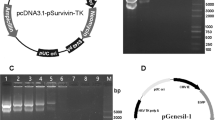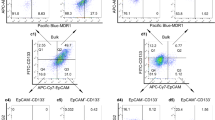Abstract
Specificity is a prerequisite for systemic gene therapy of hepatocarcinoma. In vitro, the tumor-specific viral death effector Apoptin selectively induces apoptosis in malignant hepatic cells. Intratumoral treatment of xenografted subcutaneous hepatomas with Apoptin results in tumor regression. Here, we report a systemic delivery vehicle containing the Apoptin gene linked to asialoglycoprotein (Asor), which targets asialoglycoprotein receptor (ASGPR) present only on the surface of hepatocytes. In vitro, the protein–DNA complex Asor–Apoptin induced apoptosis in HepG2 hepatocarcinoma cells but not in normal L-02 hepatocytes. Non-hepatocyte-derived tumorigenic human A549 cells lacking the membrane ASGPR were not affected by Asor–Apoptin. In vivo systemic delivery of Asor–Apoptin via the tail vein into mice bearing in situ hepatocarcinoma resulted in specific and efficient distribution of Apoptin in both hepatocarcinoma cells and normal hepatocytes. Five days after injection of Asor–Apoptin, the in situ hepatocarcinomas showed significant signs of regression, whereas the surrounding normal hepatocytes did not. Systemically delivered Asor–LacZ expressing non-apoptotic LacZ gene did not inhibit tumor growth. Our data reveal that systemic delivery of Asor–Apoptin specifically induces apoptosis in malignant hepatocytes and thus constitutes a powerful and safe therapeutics against hepatocarcinomas.
This is a preview of subscription content, access via your institution
Access options
Subscribe to this journal
Receive 12 print issues and online access
$259.00 per year
only $21.58 per issue
Buy this article
- Purchase on Springer Link
- Instant access to full article PDF
Prices may be subject to local taxes which are calculated during checkout






Similar content being viewed by others
References
Yang B, Guo A, Herman JG, Clark DP . Aberrant promoter methylation profiles of tumor suppressor genes in hepatocellular carcinoma. Am J Pathol 2003; 163: 1101–1107.
Gerolami R, Uch R, Brechot C, Mannoni P, Pagnis C . Gene therapy of hepatocarcinoma: a long way from the concept to the therapeutical impact. Cancer Gene Ther 2003; 10: 649–660.
Rohn JL, Noteborn MHM . The viral death effector Apoptin reveals tumor-specific processes. Apoptosis 2004; 9: 315–322.
Tavassoli M, Guellen L, Luxon BA, Gaken J . Apoptin: specific killer of tumor cells? Apoptosis 2005; 10: 717–724.
Teodoro JG, Heilman DW, Parker AE, Green MR . The viral protein Apoptin associates with the anaphase-promoting complex to induce G2/M arrest and apoptosis in the absence of p53. Genes Dev 2004; 18: 1952–1957.
Guelen L, Paterson H, Gaeken J, Meyers M, Farzaneh F, Tavassoli M . TAT-Apoptin is efficiently delivered and induces apoptosis in cancer cells. Oncogene 2004; 23: 1153–1165.
Zhuang S-M, Shvarts A, Jochemsen AG, van Oorschot AA, van der Eb AJ, Noteborn MH . Differential sensitivity to Ad5 E1B-21 kD and Bcl-2 proteins of Apoptin-induced versus p53-induced apoptosis. Carcinogenesis 1995; 16: 2939–2944.
Pietersen AM, Van der Eb MM, Rademaker HJ, van den Wollenberg DJ, Rabelink MJ, Kuppen PJ et al. Specific tumor-cell-killing with adenovirus vectors containing the apoptin gene. Gene Therapy 1999; 6: 882–892.
Shen Z, Wang Y, Zong Y, Qu S . Experimental study on the antitumor effect of chicken anemia virus vp3 gene against liver carcinoma in vivo. J Huazhong Univ Sci Technol Med Sci 2003; 23: 105–107, 115.
Zhang Y-H, Leliveld SR, Kooistra K, Molenaar C, Rohn JL, Tanke HJ et al. Recombinant Apoptin multimers kill tumor cells but are not-toxic and epitope-shielded in a normal-cell specific fashion. Exp Cell Res 2003; 289: 36–46.
Van der Eb MM, Pietersen AM, Speetjens FM, Kuppen PJ, van de Velde CJ, Noteborn MH et al. Gene therapy with Apoptin induces regression of xenografted human hepatomas. Cancer Gene Ther 2002; 9: 53–61.
Smith RM, Wu GY . Hepatocyte-directed gene delivery by receptor-mediated endocytosis. Semin Liver Dis 1999; 19: 83–92.
Singh M, Ariatti M . Targeted gene delivery into HepG2 cells using complexes containing DNA, cationized asialoorosomucoid and activated cationic liposomes. J Control Rel 2003; 92: 383–394.
Singh M, Kisoon N, Ariatti M . Receptor-mediated gene delivery to HepG2 cells by ternary assemblies containing cationic liposomes and cationized asialoorosomucoid. Drug Deliv 2001; 8: 29–34.
Davis BG, Robinson MA . Drug delivery systems based on sugar–macromolecule conjugates. Curr Opin Drug Discov Dev 2002; 5: 279–288.
Van Rossenberger SM, Sliedregt-Bol KM, Meeuwenoord NJ, van Berkel TJ, van Boom JH, van der Marel GA . Targeted lysosome disruptive elements for improvement of parenchymal liver cell-specific gene delivery. J Biol Chem 2002; 277: 45803–45810.
Ghosh SS, Takahashi M, Thumala NR, Parashar B, Chowdhury NR, Chowdhury JR . Liver-directed gene-therapy: promises, problems and prospects at the turn of the century. J Hepatol 2000; 32: 238–252.
McKee TD, DeRome ME, Wu GY, Findeis MA . Preparation of asialoorosomucoid–polylysine conjugates. Bioconjugate Chem 1994; 5: 306–311.
Kwoh DY, Coffin CC, Lollo CP, Jovenal J, Banaszczyk MG, Mullen P et al. Stabilization of poly-L-lysine/DNA polyplexes for in vivo gene delivery to the liver. Biochim Biophys Acta 1999; 1444: 171–190.
Han J, Il Yeom Y . Specific gene transfer mediated by galactosylated poly-L-lysine into hepatoma cells. Int J Pharmacol 2000; 202: 151–160.
Lochmann D, Jauk E, Zimmer A . Drug delivery of oligonucleotides by peptides. Eur J Pharm Biopharm 2004; 58: 237–251.
Trere D, Fiume L, De Giorgi LB, Di Stefano G, Migaldi M, Derenzini M . The asialoglycoprotein receptor in human hepatocellular carcinomas: its expression on proliferating cells. Br J Cancer 1999; 81: 404–408.
Mok TS, Leung TW, Brown G, Moyses C, Chan AT, Yeo W et al. A phase I safety and pharmacokinetic study of OGT 719 in patients with liver cancer. Acta Oncol 2004; 43: 245–251.
Havlik R, Kral V, Habib N . Gene therapy of liver tumors: results of the first clinical studies. Cas Lek Cesk 2003; 142: 370–528.
Zhu AX . Hepatocellular carcinoma: are we making progress? Cancer Invest 2003; 21: 418–428.
Tang Z-Y . Hepatocellular carcinoma – cause, treatment and metastasis. World J Gastroenterol 2001; 7: 445–454.
Kountouras J, Zavos C, Chatzopoulos D . Apoptosis in hepatocellular carcinoma. Hepatogastroenterology 2003; 50: 242–249.
Bantel H, Schulze-Osthoff K . Apoptosis in hepatitis C virus infection. Cell Death Differ 2003; 10: S48–58.
Suriawinata A, Xu R . An update on the molecular genetics of hepatocellular carcinoma. Semin Liver Dis 2004; 24: 77–88.
Watanabe J, Kushihata F, Honda K, Sugita A, Tateishi N, Mominoki K et al. Prognostic significance of Bcl-xL in human hepatocellular carcinoma. Surgery 2004; 135: 604–612.
Chun E, Lee KY . Bcl-2 and Bcl-xL are important for the induction of paclitaxel resistance in human hepatocellular carcinoma cells. Biochem Biophys Res Commun 2004; 315: 771–779.
Takehara T, Takahashi H . Suppression of Bcl-xL deamidation in human hepatocellular carcinomas. Cancer Res 2003; 63: 3054–3057.
Noteborn MH . Apoptin acts as a tumor-specific killer: potentials for an anti-tumor therapy. Cell Mol Biol 2005; 51: 49–60.
Pietersen AM . Preclinical studies with Apoptin. PhD thesis, Erasmus University, Rotterdam, The Netherlands, 2003.
Maddika S, Booy EP, Johar D, Gibson SB, Ghavami S, Los M . Cancer-specific toxicity of apoptin is independent of death receptors but involves the loss of mitochondrial membrane potential and the release of mitochondrial cell-death mediators by a Nur77-dependent pathway. J Cell Sci 2005; 118: 4485–4493.
Acknowledgements
This project was supported in part by grants from Hubei Natural Science Foundation of China (No. 2001ABA004) and Dutch Royal Society of Arts and Sciences (04CDP003).
Author information
Authors and Affiliations
Corresponding author
Rights and permissions
About this article
Cite this article
Peng, DJ., Sun, J., Wang, YZ. et al. Inhibition of hepatocarcinoma by systemic delivery of Apoptin gene via the hepatic asialoglycoprotein receptor. Cancer Gene Ther 14, 66–73 (2007). https://doi.org/10.1038/sj.cgt.7700985
Received:
Revised:
Accepted:
Published:
Issue Date:
DOI: https://doi.org/10.1038/sj.cgt.7700985
Keywords
This article is cited by
-
A novel anti-CD22 scFv–apoptin fusion protein induces apoptosis in malignant B-cells
AMB Express (2017)
-
Combination of VP3 and CD147-knockdown enhance apoptosis and tumor growth delay index in colorectal tumor allograft
BMC Cancer (2016)
-
Active radar guides missile to its target: receptor-based targeted treatment of hepatocellular carcinoma by nanoparticulate systems
Tumor Biology (2015)
-
Towards novel paradigms for cancer therapy
Oncogene (2011)
-
What can we learn from virus in designing nonviral gene vectors
Chinese Journal of Polymer Science (2011)



